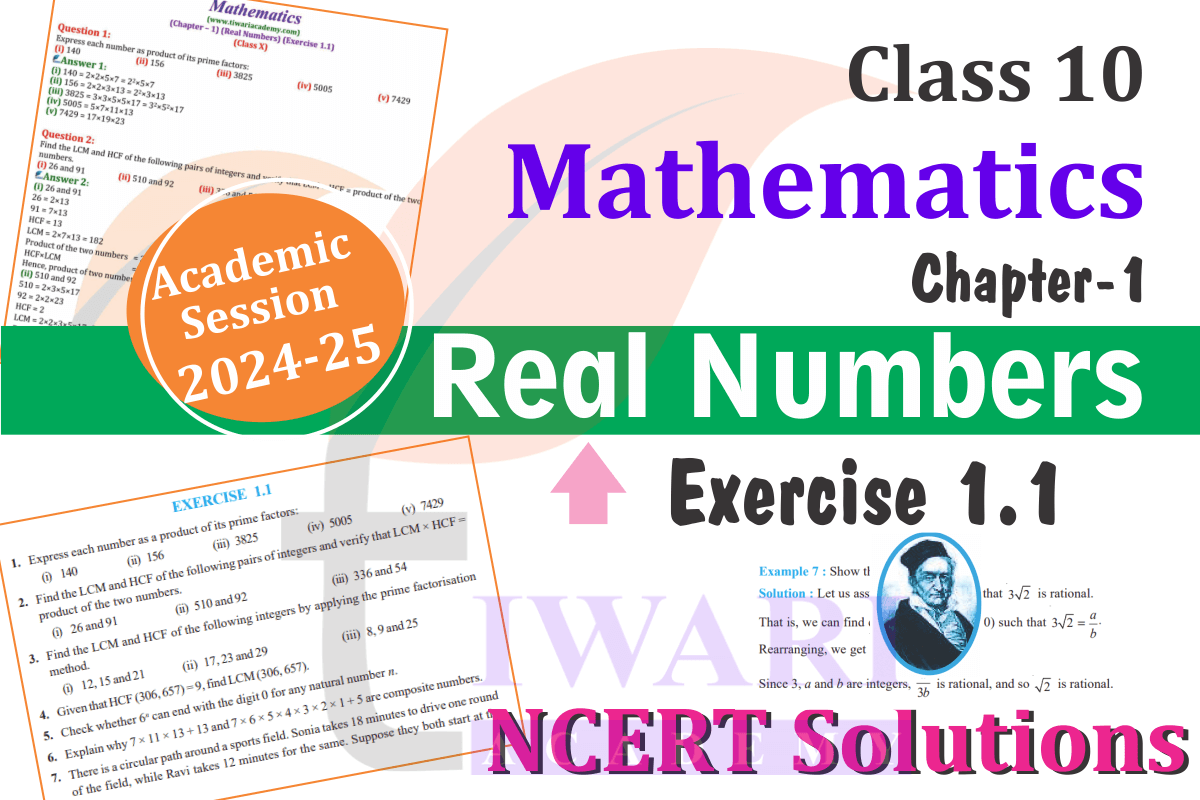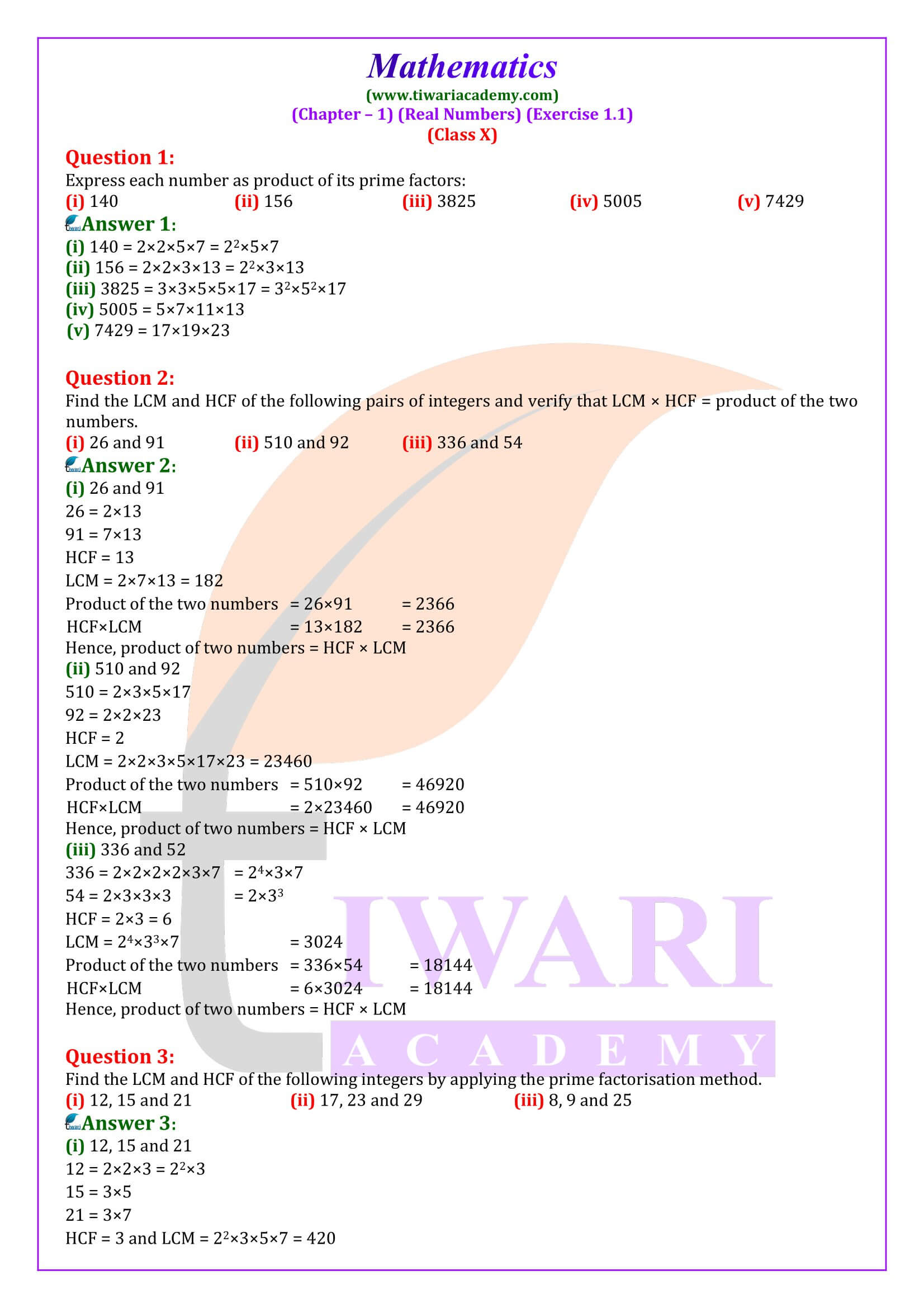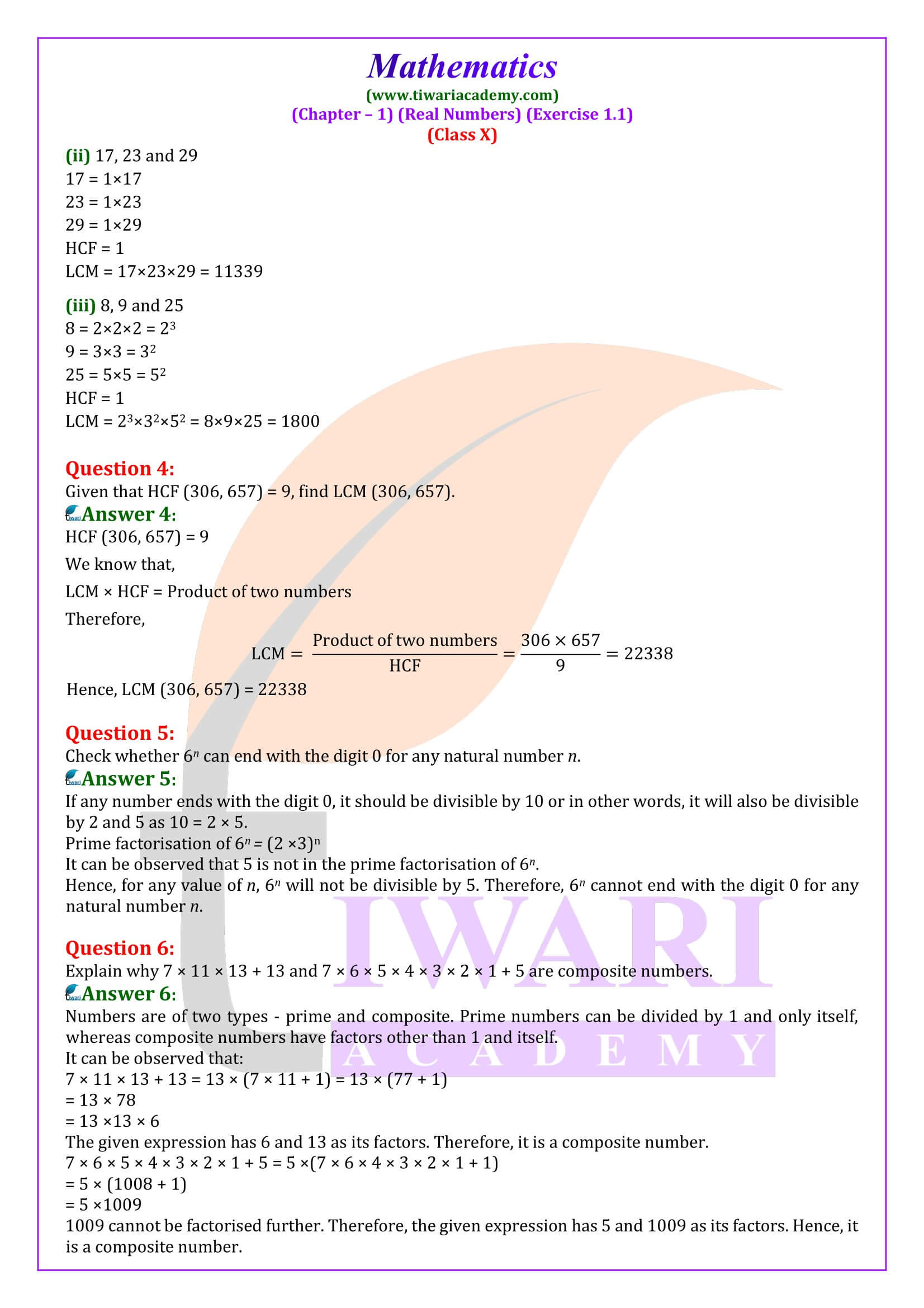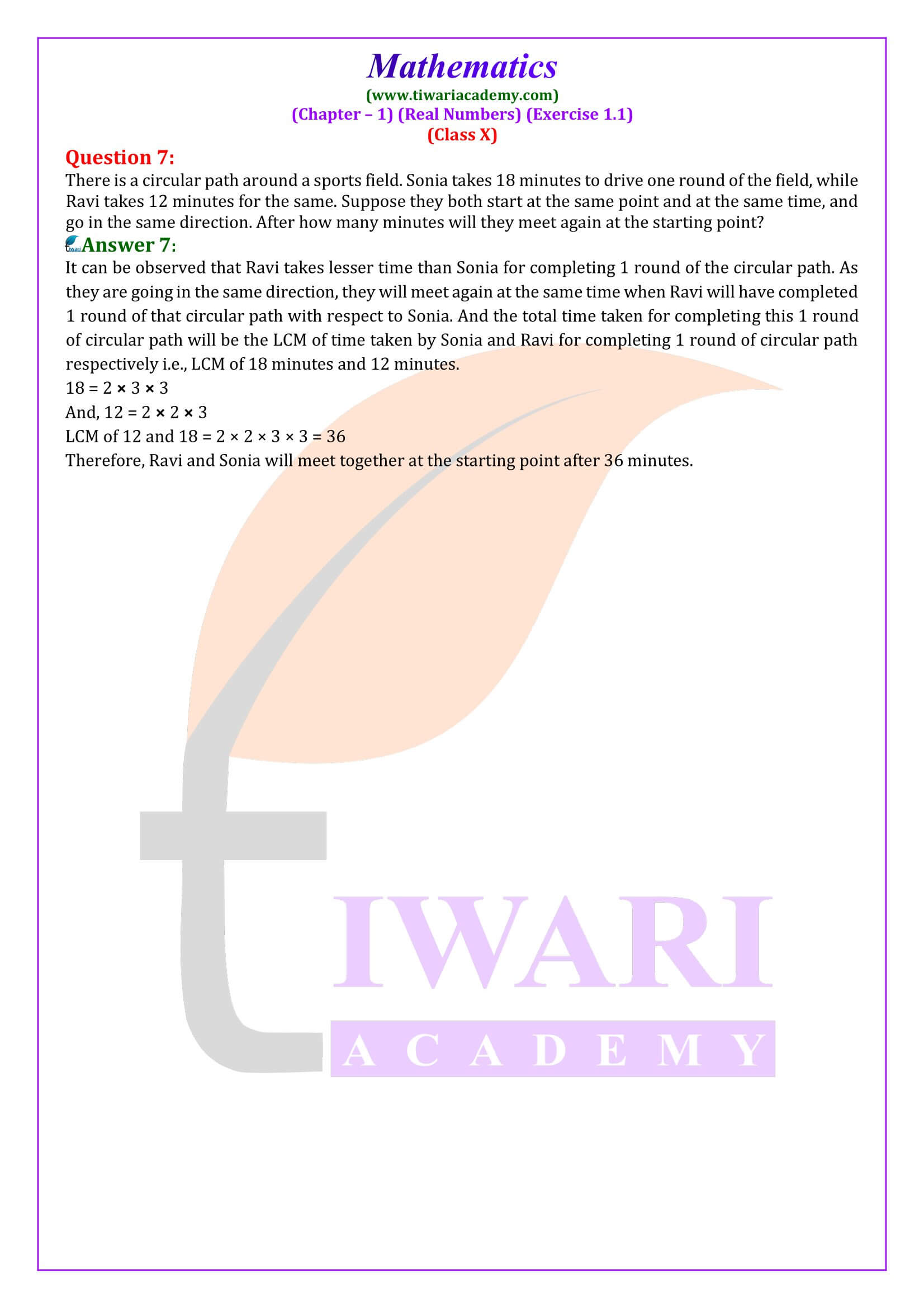NCERT Solutions for Class 10 Maths Chapter 1 Exercise 1.1 (Ex. 1.1) Real Numbers in Hindi and English Medium modified and updated for academic year 2024-25. Solutions of 10th mathematics Exercise 1.1 is revised for session 2024-25 based on new NCERT Books.
| Class: 10 | Mathematics |
| Chapter 1: | Exercise 1.1 |
| Topic: | Real Numbers |
| Content: | Exercise Solutions and Extra Questions |
| Session: | Academic Year 2024-25 |
| Medium: | English and Hindi Medium |

Class 10 Maths Chapter 1 Exercise 1.1 Question 1
Express each number as product of its prime factors:
- (i) 140
- (ii) 156
- (iii) 3825
- (iv) 5005
- (v) 7429
Solution:
(i) 140 = 2 × 2 × 5 × 7 = 2² × 5 × 7
Discuss this question in your opinion.
(ii) 156 = 2 × 2 × 3 × 13 = 2² × 3 × 13
If you have any other suggestion, please suggest us.
(iii) 3825 = 3 × 3 × 5 × 5 × 17 = 3² × 5² × 17
More options related to above question.
(iv) 5005 = 5 × 7 × 11 × 13
if you have any other idea, please comment here.
(v) 7429 = 17 × 19 × 23
What do you think about 10th Maths Exercise 1.1 Part v solutions?
Class 10 Maths Chapter 1 Exercise 1.1 Question 2
Find the LCM and HCF of the following pairs of integers and verify that LCM × HCF = Product of the two numbers.
- (i) 26 and 91
- (ii) 510 and 92
- (iii) 336 and 54
Solution:
(i) 26 and 91
26 = 2 × 13
91 = 7 × 13
HCF = 13
LCM = 2 × 7 × 13 = 182
Product of the two numbers = 26×91 = 2366
HCF × LCM = 13 × 182 = 2366
Hence, product of two numbers = HCF × LCM
Do you have more ideas about this solutions?
(ii) 510 and 92
510 = 2 × 3 × 5 × 17
92 = 2 × 2 × 23
HCF = 2
LCM = 2 × 2 × 3 × 5 × 17 × 23 = 23460
Product of the two numbers = 510 × 92 = 46920
HCF × LCM = 2 × 23460 = 46920
Hence, product of two numbers = HCF × LCM
You can discuss this question with us.
(iii) 336 and 54
336 = 2 × 2 × 2 × 2 × 3 × 7 = 2⁴ × 3 × 7
54 = 2 × 3 × 3 × 3 = 2 × 3³
HCF = 2 × 3 = 6
LCM = 2⁴ × 3³ × 7 = 3024
Product of the two numbers = 336 × 54 = 18144
HCF × LCM = 6 × 3024 = 18144
Hence, product of two numbers = HCF × LCM
Comment about the solution here.
Class 10 Maths Chapter 1 Exercise 1.1 Question 3
Find the LCM and HCF of the following integers by applying the prime factorisation method.
- (i) 12, 15 and 21
- (ii) 17, 23 and 29
- (iii) 8, 9 and 25
Solution:
(i) 12, 15 and 21
12 = 2 × 2 × 3 = 2² × 3
15 = 3 × 5
21 = 3 × 7
HCF = 3
LCM = 2² × 3 × 5 × 7 = 420
For more suggestion, see the solution here.
(ii) 17, 23 and 29
17 = 1 × 17
23 = 1 × 23
29 = 1 × 29
HCF = 1
LCM = 17 × 23 × 29 = 11339
Prove more ways to solve this question.
(iii) 8, 9 and 25
8 = 2 × 2 × 2 = 2³
9 = 3 × 3 = 3²
25 = 5 × 5 = 5²
HCF = 1
LCM = 2³ × 3² × 5² = 8 × 9 × 25 = 1800
How can we solve this question alternatively?
Class 10 Maths Chapter 1 Exercise 1.1 Question 4
Given that HCF (306, 657) = 9, find LCM (306, 657).
Solution:
HCF (306, 657) = 9
We know that,
LCM × HCF = Product of two numbers
Therefore,
LCM= (Product of two numbers)/HCF = (306 × 657)/9 = 22338
Hence, LCM (306, 657) = 22338
The alternative way to solve this question.
Class 10 Maths Chapter 1 Exercise 1.1 Question 5
Check whether 6ⁿ can end with the digit 0 for any natural number n.
Solution:
If any number ends with the digit 0, it should be divisible by 10 or in other words, it will also be divisible by 2 and 5 as 10 = 2 × 5.
Prime factorisation of 6ⁿ = (2 × 3)ⁿ
According to Fundamental Theorem of Arithmetic, the factorisation is uniqe. It can be observed that 5 is not in the prime factorisation of 6ⁿ.
Hence, for any value of n, 6n will not be divisible by 5. Therefore, 6n cannot end with the digit 0 for any natural number n.
Put your opinion about question 5 of 10th Maths exercise 1.1
Class 10 Maths Chapter 1 Exercise 1.1 Question 6
Explain why 7 × 11 × 13 + 13 and 7 × 6 × 5 × 4 × 3 × 2 × 1 + 5 are composite numbers.
Solution:
Numbers are of two types – prime and composite. Prime numbers can be divided by 1 and only itself, whereas composite numbers have factors other than 1 and itself.
It can be observed that:
7 × 11 × 13 + 13 = 13 × (7 × 11 + 1) = 13 × (77 + 1)
= 13 × 78
= 13 × 13 × 6
The given expression has 6 and 13 as its factors. Therefore, it is a composite number.
Now: 7 × 6 × 5 × 4 × 3 × 2 × 1 + 5 = 5 ×(7 × 6 × 4 × 3 × 2 × 1 + 1)
= 5 × (1008 + 1)
= 5 × 1009
1009 cannot be factorised further. Therefore, the given expression has 5 and 1009 as its factors. Hence, it is a composite number.
For any further suggestion, please visit here.
Class 10 Maths Chapter 1 Exercise 1.1 Question 7
There is a circular path around a sports field. Sonia takes 18 minutes to drive one round of the field, while Ravi takes 12 minutes for the same. Suppose they both start at the same point and at the same time, and go in the same direction. After how many minutes will they meet again at the starting point?
Solution:
It can be observed that Ravi takes lesser time than Sonia for completing 1 round of the circular path. As they are going in the same direction, they will meet again at the same time when Ravi will have completed 1 round of that circular path with respect to Sonia. And the total time taken for completing this 1 round of circular path will be the LCM of time taken by Sonia and Ravi for completing 1 round of circular path respectively i.e., LCM of 18 minutes and 12 minutes.
18 = 2 × 3 × 3
And, 12 = 2 × 2 × 3
LCM of 12 and 18 = 2 × 2 × 3 × 3 = 36
Therefore, Ravi and Sonia will meet together at the starting point after 36 minutes.
What do you think about the solution of question 7 given in Ex. 1.1 of 10th Maths.
10 Maths Chapter 1 Exercise 1.1 Solutions
NCERT Solutions for class 10 Maths Chapter 1 Exercise 1.1 Real Numbers in English medium as well as Hindi Medium is given below to free download in PDF format for 2024-25. IF YOU WANT TO DOWNLOAD, THE LINK IS ALSO GIVEN or visit NCERT Solutions for Class 10 Maths Chapter 1 to download other exercises.
Important Questions on REAL NUMBERS
1. In a seminar, the number of participants in English, Maths and Science are 175, 140 and 105, respectively. Find the minimum number of rooms required if in each room the same number of participants are to be seated and all of them being in the same subject. [Answer: 12]
2. Find the value of m if HCF of 65 and 117 is expressible in the form 65m – 117. [Answer: 2]
3. What can you say about the product of a non-zero rational and irrational number? [Answer: Irrational]
4. In a school there are two sections of class X – section A and section B. There are 48 students in sections A and 54 students in section B. Determine the least number of books required for the library of the school so that the books can be distributed equally among students of section A or section B? [Answer: 216]
5. After how many places the decimal expansion of 13497/1250 will terminate? [Answer: 4]
6. Find the least number which is divisible by all numbers from 1 to 10 (both inclusive). [Answer: 2520]
Practice Questions on Real Numbers
- A circular field has a circumference of 360 km. Three cyclists start together and can cycle 48 km, 60 km and 72 km a day, round the field. After how many days will they meet again at the starting point? [Answer: 30 days]
- The numbers 525 and 3000 are divisible by 3, 5, 15, 25 and 75 what is the HCF of 525 and 3000? [Answer: 75]
- Can two numbers have 18 as their HCF and 380 as their LCM? Give reasons. [Answer: No]
- If a = 4q + r then what are the condition for a and q? What are the values that r can take? [Answer: a and q are positive integer 0 ≤ r ≤ 4]
- What is the digit at unit’s place of 9^n? [Answer: Even power = 1, odd power = 9]
- If n is an odd integer then show that n² – 1 is divisible by 8.
- Use Euclid’s division algorithm to find the HCF of 16 and 28. [Answer: 4]
Important questions for 10th Maths Exercise 1.1
What is fundamental theorem of Arithmetic?
According to fundamental theorem of arithmetic:
Every composite number can be expressed ( factorised) as a product of primes, and this factorisation is unique, apart from the order in which the prime factors occur.
225 can be expressed as (a) 5 x 3^2 (b) 5^2 x 3 (c) 5^2 x 3^2 (d) 5^3 x 3. [CBSE 2020] [Maths Basic]
225 = 3 x 3 x 5 x 5 = 3^2 x 5^2.
Hence, Option (c) is correct.
The total number of factors of a prime number is (a) 1 (b) 0 (c) 2 (d) 3. [CBSE 2020] [Maths Standard]
The total number of factors of a prime number is 2. One is 1 and other is itself number.
Hence, Option (c) is correct.
The HCF and the LCM of 12, 21, 15 respectively are (a) 3, 140 (b) 12, 120 ((c) 3, 420 (d) 420, 3 [CBSE 2020] [Maths Standard]
12 = 2 x 2 x 3
21 = 3 x 7
15 = 3 x 5
HCF = 3
LCM = 2 x 2 x 3 x 7 x 5 = 420
Hence, Option (c) is correct.
Ask your doubts related to NIOS or CBSE Board and share your knowledge with your friends and other users through Discussion Forum.
How many questions are there in Class 10 Maths Exercise 1.1?
There are in all 7 questions in exercise 1.1 of class 10th mathematics chapter 1 (Real numbers) and every question is different from each other.
Which example is important for exercise 1.1 of 10th mathematics?
4 examples are based on exercise 1.1 (chapter 1 Real numbers) of class 10th mathematics. Example 5 and question 5 are based on same concept, example 7 and question 4 are based on same formula and examples 6, 8 and question 3 are same. All the examples are important for the exams as well as school tests.
What are the Important and difficult questions from exercise 1.1 in 10th Maths?
Question number 2, 4, 5 and 7 of exercise 1.1 of class 10th mathematics chapter 1 (Real numbers) are important and difficulty level of questions varies from student to student.
But questions which most of students find little difficult in this exercise are Q5, 6 and 7.
Which topics students should recall before starting exercise 1.1 of 10th Maths?
Before starting exercise 1.1 (chapter 1 Real numbers) of class 10th mathematics, Students should recall meaning of:
Factors.
HCF (Highest Common Factor) and LCM (Lowest/Least Common Multiple).
Prime numbers, Composite numbers, Natural numbers.







